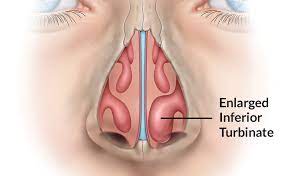
Inferior turbinate hypertrophy is the most common cause of chronic nasal obstruction. When conservative medical treatment options fail in patients with inferior turbinate hypertrophy, reduction of the inferior turbinate can be performed using surgical techniques. Laser-assisted turbinate surgery has emerged as a viable option, with various lasers explored in treating ITH. Among these, the diode laser, operating at 980nm, stands out for its portability, cost-effectiveness, and controllable coagulating abilities in the deep layers of the turbinate.
Benefits of Diode Laser in Turbinate Surgery:
Limited Submucosal Scarring and Venous Sinusoid Obliteration:Studies have consistently shown that laser-assisted turbinate surgery, particularly with the diode laser, leads to limited submucosal scarring and the obliteration of venous sinusoids. This unique mechanism results in the shrinkage of the turbinate, effectively relieving nasal obstruction.
Coagulating Ability and Tissue Absorption:The diode laser, with its wavelength of 980nm, is primarily absorbed by water and blood. This characteristic renders it highly effective in coagulating tissues. Its coagulating ability in the deep layers of the turbinate is more controllable than other lasers, contributing to the precision of the surgical process.
Many ENT experts/doctors have been studied on this for many years. And different lasers have been used to treat ITH, The studies results that Laser-assisted turbinate surgery causes limited submucosal scarring and obliteration of the venous sinusoids, shrinking the turbinate and relieving nasal obstruction. The diode laser is the most portable and lowest cost of the lasers available at present for endonasal treatment. The coagulating ability of the diode laser is more controllable in the deep layer of the turbinate. Diode laser light 980nm is absorbed primarily by water and blood and has excellent coagulating abilities. The coagulating capability of non-contact type of lasers is not as deep as that of other lasers, but working with proper fiber can ablate soft tissues without causing excessive collateral damage, which may help to avoid complications, especially in areas adjacent to the orbit.
Clinical Research Findings:
Clinical researches observed that the success rates in diode laser-assisted turbinate reduction were satisfactory. They also observed that side effects of the diode laser were fewer than those with other laser. The side effects here means includes minimal bleeding, which did not require nasal packing, and nasal swelling that improved in a few days. The diode laser technology is the newest addition to the list for nasal applications, and being one of the most portable and lowest cost of the lasers available for turbinate surgery. All of these makes the diode laser possible for turbinate reduction to be performed under topical anesthesia within a short period of time with excellent patient acceptance.
Advantages of Diode Laser Technology:
Portability and Cost-Effectiveness:The diode laser's compact design makes it highly portable, enhancing its accessibility in clinical settings. Its cost-effectiveness further underscores its appeal, especially when compared to other laser options. This aspect makes the diode laser a practical choice for medical professionals seeking efficient solutions for turbinate surgery.
Precision in Coagulation:One of the distinguishing features of the diode surgical laser is its precise coagulating ability in the deep layers of the turbinate. This attribute is crucial in achieving the desired surgical outcomes while minimizing collateral damage, particularly in areas adjacent to the orbit.
Conclusion:
In conclusion, diode laser-assisted turbinate surgery has proven to be a valuable and effective intervention for patients with inferior turbinate hypertrophy. The combination of its portability, cost-effectiveness, and precise coagulating abilities positions the diode laser as a practical choice in the realm of nasal applications. Clinical research has consistently demonstrated high success rates and minimal side effects, further supporting its use in addressing chronic nasal obstruction. As the newest addition to the array of lasers available for turbinate surgery, the diode laser stands out for its ability to provide efficient and well-tolerated procedures, ultimately benefiting both medical professionals and patients alike.